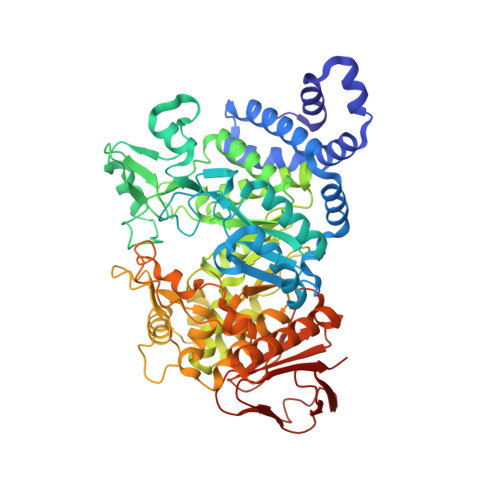Crystal structure of the covalent intermediate of amylosucrase from Neisseria polysaccharea.
Jensen, M.H., Mirza, O., Albenne, C., Remaud-Simeon, M., Monsan, P., Gajhede, M., Skov, L.K.(2004) Biochemistry 43: 3104-3110
- PubMed: 15023061
- DOI: https://doi.org/10.1021/bi0357762
- Primary Citation of Related Structures:
1S46 - PubMed Abstract:
The alpha-retaining amylosucrase from the glycoside hydrolase family 13 performs a transfer reaction of a glucosyl moiety from sucrose to an acceptor molecule. Amylosucrase has previously been shown to be able to use alpha-D-glucopyranosyl fluoride as a substrate, which suggested that it could also be used for trapping the reaction intermediate for crystallographic studies. In this paper, the crystal structure of the acid/base catalyst mutant, E328Q, with a covalently bound glucopyranosyl moiety is presented. Sucrose cocrystallized crystals were soaked with alpha-D-glucopyranosyl fluoride, which resulted in the trapping of a covalent intermediate in the active site of the enzyme. The structure is refined to a resolution of 2.2 A and showed that binding of the covalent intermediate resulted in a backbone movement of 1 A around the location of the nucleophile, Asp286. This structure reveals the first covalent intermediate of an alpha-retaining glycoside hydrolase where the glucosyl moiety is identical to the expected biologically relevant entity. Comparison to other enzymes with anticipated glucosylic covalent intermediates suggests that this structure is a representative model for such intermediates. Analysis of the active site shows how oligosaccharide binding disrupts the putative nucleophilic water binding site found in the hydrolases of the GH family 13. This reveals important parts of the structural background for the shift in function from hydrolase to transglycosidase seen in amylosucrase.
Organizational Affiliation:
Structural Biology Group, Department of Medicinal Chemistry, The Danish University of Pharmaceutical Sciences, Universitetsparken 2, DK-2100 Copenhagen, Denmark.















